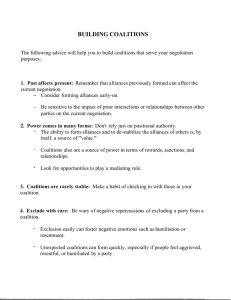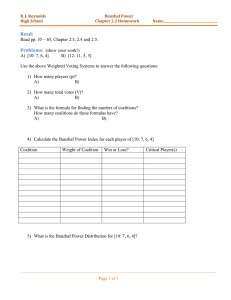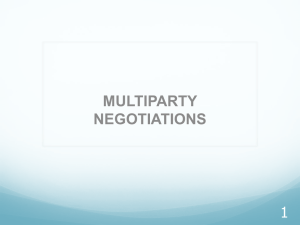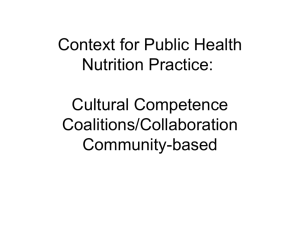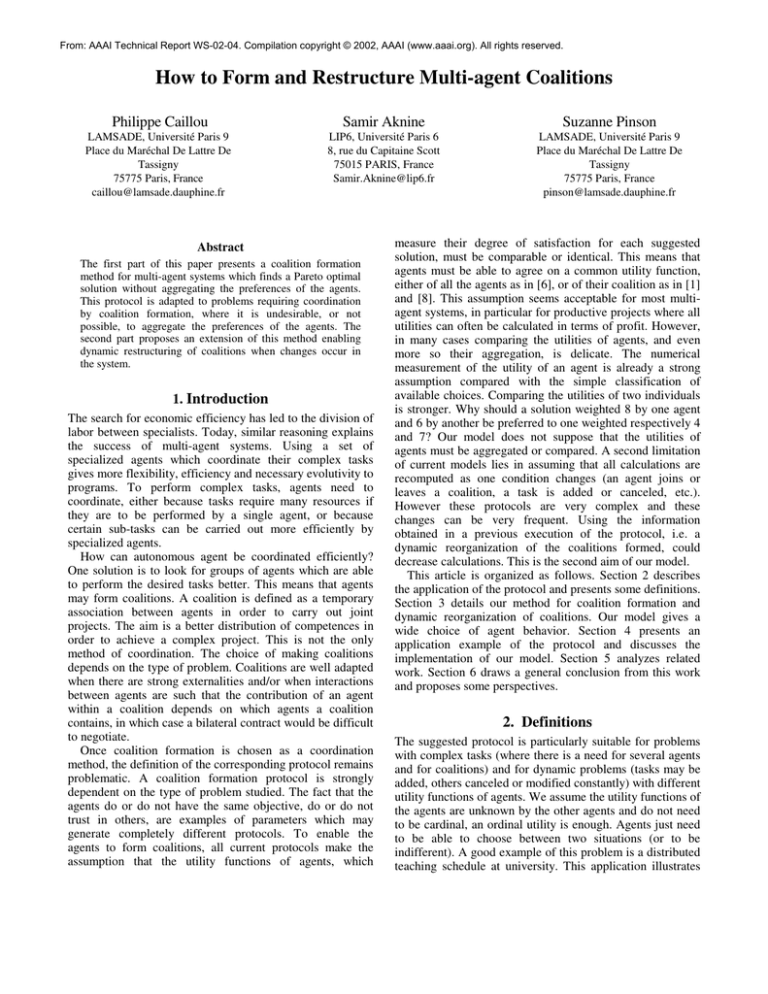
From: AAAI Technical Report WS-02-04. Compilation copyright © 2002, AAAI (www.aaai.org). All rights reserved.
How to Form and Restructure Multi-agent Coalitions
Philippe Caillou
Samir Aknine
Suzanne Pinson
LAMSADE, Université Paris 9
Place du Maréchal De Lattre De
Tassigny
75775 Paris, France
caillou@lamsade.dauphine.fr
LIP6, Université Paris 6
8, rue du Capitaine Scott
75015 PARIS, France
Samir.Aknine@lip6.fr
LAMSADE, Université Paris 9
Place du Maréchal De Lattre De
Tassigny
75775 Paris, France
pinson@lamsade.dauphine.fr
Abstract
The first part of this paper presents a coalition formation
method for multi-agent systems which finds a Pareto optimal
solution without aggregating the preferences of the agents.
This protocol is adapted to problems requiring coordination
by coalition formation, where it is undesirable, or not
possible, to aggregate the preferences of the agents. The
second part proposes an extension of this method enabling
dynamic restructuring of coalitions when changes occur in
the system.
1. Introduction
The search for economic efficiency has led to the division of
labor between specialists. Today, similar reasoning explains
the success of multi-agent systems. Using a set of
specialized agents which coordinate their complex tasks
gives more flexibility, efficiency and necessary evolutivity to
programs. To perform complex tasks, agents need to
coordinate, either because tasks require many resources if
they are to be performed by a single agent, or because
certain sub-tasks can be carried out more efficiently by
specialized agents.
How can autonomous agent be coordinated efficiently?
One solution is to look for groups of agents which are able
to perform the desired tasks better. This means that agents
may form coalitions. A coalition is defined as a temporary
association between agents in order to carry out joint
projects. The aim is a better distribution of competences in
order to achieve a complex project. This is not the only
method of coordination. The choice of making coalitions
depends on the type of problem. Coalitions are well adapted
when there are strong externalities and/or when interactions
between agents are such that the contribution of an agent
within a coalition depends on which agents a coalition
contains, in which case a bilateral contract would be difficult
to negotiate.
Once coalition formation is chosen as a coordination
method, the definition of the corresponding protocol remains
problematic. A coalition formation protocol is strongly
dependent on the type of problem studied. The fact that the
agents do or do not have the same objective, do or do not
trust in others, are examples of parameters which may
generate completely different protocols. To enable the
agents to form coalitions, all current protocols make the
assumption that the utility functions of agents, which
measure their degree of satisfaction for each suggested
solution, must be comparable or identical. This means that
agents must be able to agree on a common utility function,
either of all the agents as in [6], or of their coalition as in [1]
and [8]. This assumption seems acceptable for most multiagent systems, in particular for productive projects where all
utilities can often be calculated in terms of profit. However,
in many cases comparing the utilities of agents, and even
more so their aggregation, is delicate. The numerical
measurement of the utility of an agent is already a strong
assumption compared with the simple classification of
available choices. Comparing the utilities of two individuals
is stronger. Why should a solution weighted 8 by one agent
and 6 by another be preferred to one weighted respectively 4
and 7? Our model does not suppose that the utilities of
agents must be aggregated or compared. A second limitation
of current models lies in assuming that all calculations are
recomputed as one condition changes (an agent joins or
leaves a coalition, a task is added or canceled, etc.).
However these protocols are very complex and these
changes can be very frequent. Using the information
obtained in a previous execution of the protocol, i.e. a
dynamic reorganization of the coalitions formed, could
decrease calculations. This is the second aim of our model.
This article is organized as follows. Section 2 describes
the application of the protocol and presents some definitions.
Section 3 details our method for coalition formation and
dynamic reorganization of coalitions. Our model gives a
wide choice of agent behavior. Section 4 presents an
application example of the protocol and discusses the
implementation of our model. Section 5 analyzes related
work. Section 6 draws a general conclusion from this work
and proposes some perspectives.
2. Definitions
The suggested protocol is particularly suitable for problems
with complex tasks (where there is a need for several agents
and for coalitions) and for dynamic problems (tasks may be
added, others canceled or modified constantly) with different
utility functions of agents. We assume the utility functions of
the agents are unknown by the other agents and do not need
to be cardinal, an ordinal utility is enough. Agents just need
to be able to choose between two situations (or to be
indifferent). A good example of this problem is a distributed
teaching schedule at university. This application illustrates
the dynamic evolution of the coalitions, as often a course
may be added or removed, or a professor or a group of
students may join the establishment. In this example we
consider two types of agents: professors and groups of
students. The classes correspond to the tasks to be carried
out. Thus, agents form a coalition for each class. Most
coalitions are formed of two agents: a professor agent and a
student agent (having more agents in a coalition is also
possible, for instance for lectures with several groups of
students). Each (student or professor) agent defines the
utility it assigns to each schedule. Since its utility function
is ordinal, it just needs to be able to compare two schedules
and to say which it prefers or that it is indifferent. Agents
are free to choose their parameters while computing their
utility. A professor can thus prefer the morning, refuse
Monday, prefer certain classes, like a stable schedule, etc.
In a general way, the choice of an agent depends on the
members of the coalitions in which it will take part. But its
appreciation of a coalition may also vary according to the
other coalitions. This introduces externalities or an ordered
processing of tasks.
Let us now give some useful definitions for our method.
Coalition: a coalition is formed for each task. It contains
zero, one or more agents which will carry out actions in
order to achieve a task. Each action and its parameters are
defined (for instance, the parameters of the action “taking a
class” are: the week, the day and the time).
Coalition set: a coalition set represents a solution to the
problem of coalition formation. It contains as many
coalitions as tasks to be performed at a given moment (in
our application, a set corresponds to one schedule).
Group of coalition sets: a group of coalition sets
corresponds to several sets of coalitions brought together in
order to be computed and transmitted collectively (for
instance, several possible schedules). In the rest of this
article, if will be referred to as a group of sets or simply a
group. When an agent computes a group of equivalent sets,
this means that it is indifferent regarding all the sets of
coalitions in this group (for instance, it computes a group
with those schedules that it prefers to others and that it
cannot classify).
Context: a set of unspecified parameters which must be
stable during a negotiation step. For instance, it may
concern a date or any external parameter.
Utility function: the utility function may be ordinal or
cardinal. If it is cardinal, it associates a utility with a set of
coalitions within a given context. If it is ordinal, it
compares two sets in a given context. In this case,
measuring the utility of a set means comparing it with a
reference situation which will be the same one throughout
the negotiation.
Reference situation: so that the agents know if they
have to accept a set of coalitions as a solution, they need to
be able to compare it with what they are sure to obtain
during the negotiation. This minimum is the reference
situation. If no coalition has yet been formed, the reference
situation is the situation where nobody does anything. If
there are already coalitions, it is the current situation, with
possibly some changes in order to take into account new
information (cf. section 3). To be sure to find a solution
after a negotiation, the reference situation needs to be
feasible and to be the same for all the agents.
Acceptable set: we consider that a set is acceptable for
an agent if it is preferred or equivalent to the current
reference situation.
Pareto optimum: a Pareto optimum is a situation where
it is not possible to improve the situation of an agent
without deteriorating that of at least one other.
3. Coordination Method
3.1. Presentation
As we do not intend to aggregate the utilities of the agents,
we seek a solution which is "objectively good", i.e. which
may not be contested by any agent. A logical criterion
likely to be accepted by all the agents is that we cannot
increase the utility of an individual without deteriorating
that of at least one other. If this does not happen, i.e. there
is a situation such that we can increase the utility of an
individual without deteriorating that of another, there is no
reason not to prefer this situation. The solution must thus
be a Pareto optimum.
Which Pareto optimum should we choose? Now the
problem is to compare the utilities of different agents. How
should we choose between a schedule which is the first
choice of a professor and another which is the first choice
of a student? One solution is to avoid making a choice but
to find a Pareto optimum. This offers the advantage of
reducing computations as agents are not obliged to
compute them all. The only constraint is that each agent
should find it interests in accepting this solution, therefore
in prefering this solution to the initial situation. The first
aim of our protocol is thus to find a Pareto optimum likely
to be accepted by all the agents as early as possible.
How is a Pareto optimum obtained? The agent which
initiates a negotiation seeks one or more sets of coalitions it
prefers (cf. section 5) and chooses an agent to which it
sends them (cf. section 3.2). Then it seeks the set(s) that it
would choose as a second choice and sends them to that
agent, and so on, until there are no more sets at least
equivalent to the current situation. When an agent receives
a group of sets, it evaluates them and sends them to the
next agent sorted in decreasing order of preference. When
an agent receives a group of sets, if there is at least one set
which is preferable or equivalent to the current situation
and if all the agents have already taken part in the
negotiation, the set of this group that it prefers is a Pareto
optimum and may be used as a solution set for the
negotiation. For instance, let us consider two agents and
seven sets of possible coalitions. Let E(U1;U2) be the
relative utilities of agents 1 and 2 for the set E. Having E0
as the initial situation, the seven possible sets are: E0(0;0);
E1(0;10); E2(2;8); E3(4;8); E4(4;5); E5(-2;2); E6(10;-1) (cf.
figure 1). Of these seven sets, three are Pareto optima (E1,
E3 and E6).
U2
E1
E2
E3
E4
E5
E0
U1
E6
Figure 1. Describing all possible solutions in a utility space
Agent 1 initiates the negotiation. It sorts all the
acceptable sets for it in equivalent groups of sets (cf. figure
2): G1(E6); G2(E4;E3); G3(E2); G4(E0;E1). E5 is not sorted as
the reference situation (E0) is better.
G4
G3
E1
G2
G1
E3
E5 E0 E2
U1=0
E4
E6
U1
Figure 2. Group of sets of agent 1
Groups G1, G2, G3 and G4 are sent in this order to the
next agent. Thus, agent 2 starts by receiving G1 and
evaluates it. Set E6 is unacceptable for the agent because it
would bring a less satisfactory situation than the initial
situation (figure 3). The agent does not send this set and
waits for the rest. It receives G2 and sorts it into two sets
(figure 4) in two groups G’1(E3) and G’2(E4). G’1 is
acceptable. As all the other agents have already
participated in the negotiation, agent 2 cannot send it. All
the sets of G’1 can thus be a solution. The agent must
choose E3, which is Pareto optimal. It sends this set to
agent 1 in order to inform it of the result of the negotiation.
U2
U2=0
E6
Figure 3. First group of agent 2
U2
E3
G’1
E4
G’2
U2=0
Figure 4. Second group of agent 2
3.2. Algorithm
The negotiation process is based on three phases:
initialization of the negotiation and transfer of tasks,
negotiation, transmission of the solution. We can
distinguish the behavior of the agent which initiates the
negotiation from the intermediate and final agents which
take part in the negotiation. The order of the agents can
differ from one negotiation to another. Each agent can be in
any position. However, the order must be stable during a
given negotiation.
- Phase 1. Initialization of the negotiation and transfer of
tasks. Any agent can initiate the negotiation. This action
can result when a new task appears or when an agent
modifies its preferences. The initiator agent informs the
others that it begins a new negotiation and any agent which
wants to begin another negotiation, must wait until the end
of the negotiation in progress. To avoid conflicts between
two simultaneous requests, each agent sends a
confirmation. Each agent asks the other agents to send it
their tasks. It then deduces the set of tasks to be performed
and associates each one with a coalition. The initiator agent
computes the sets of coalitions (cf. section 4 regarding
complexity), gathers them in a group of sets and sends this
group to the agent which must initiate the negotiation.
Heuristics can be used to find the best group according to
the context and the application. This improves the
complexity of the algorithms.
An example is to use and transmit undeveloped coalitions,
i.e. the tasks for which all possible coalitions have not yet
been computed. If an agent receives an undeveloped
coalition in a set and this coalition cannot affect its utility
(if it joins it or not), it leaves it aside and does not compute
it. If it can, it computes all the possible combinations for
the corresponding task.
- Phase 2. Negotiation. When an agent receives a group
of sets, it sorts the sets in order of preference into
homogeneous new groups of sets. In these groups, all sets
are equivalent in terms of agent utility. The agent sorts only
these sets that are least equivalent to the reference
situation. The others are not considered.
If the agent is not the last agent, it sends its new groups to
the next agent in decreasing order of preference. If it is the
last agent, and if this agent has created new groups because
it has found acceptable sets, it considers that all the sets of
the best new group are Pareto optima. It can thus choose
one of them randomly and it will be the solution for the
negotiation
- Phase 3: Transmission of the solution. Once the last
agent has identified a Pareto optimal solution, it sends this
set to the other agents which accept it as the solution for the
negotiation.
Our protocol provides a solution, i.e. a set of coalitions
with the initial conditions (utility functions, a set of tasks
and a context). What happens if a change occurs in one of
these conditions, for instance if a task is added or removed,
or if an agent modifies its utility function? In current
protocols, all the calculations must be redone to find a new
solution to the problem. It seems a pity not to use the
results obtained in the current situation. New information
should be added to the previous conditions, it should not
completely replace them. A simple means to use earlier
calculations is to start from the current solution. Instead of
evaluating the different sets compared to an initial situation
where no agent does anything, the agents will evaluate the
new solutions compared to the current solution. As the
solution is at least equivalent to the initial situation for all
the agents (since it is Pareto optimal), it is difficult to find a
similar or better one. Thus, fewer sets and groups of sets
will be forwarded and evaluated. This will accelerate the
problem solving process.
The new reference situation must remain feasible and
identical for all agents in spite of the new information.
Thus it is not the current situation which is used as the
reference situation but the modified current situation, in
which all the changes have been taken into account. For
instance, for an agent which leaves, the reference situation
will be the current set of coalitions without this agent. For a
removed task, it will be the current set of coalitions minus
the coalition corresponding to the task.
Heuristics can be used to find the best group according to
the context and the application. This improves the
complexity of the algorithms. The simplest solution
(without heuristic) is that the first negotiator agent
computes all the possible sets and then each agent makes
an exhaustive classification of all the possible sets. The
advantage of this solution is that it is simple, but it leads to
a higher complexity, especially for the first agent. Other
search methods can serve to improve the computation
complexity and to distribute the calculations among the
various agents.
- Using undeveloped coalitions. The proposed method
using undeveloped coalitions reduces the calculations and
the volume of the information transferred while preserving
the ease of calculation by the agents.
- Tests of intermediate acceptability. A complementary
solution in order to reduce the number of iterations is to
test if an (incompletely developed) set can be potentially
preferred to the reference situation. If this is not the case, it
will not be necessary to develop it. Thus this branch of the
exploration tree can be forgotten. These tests are especially
useful during the restructuring of coalitions. The reference
situation is then the current situation that is likely to be
very satisfactory for the agent. This agent can easily set
aside many sets which will not give a better solution,
especially if the agent does not prefer changes in its
situation.
- Search limited to the best group. The aim of an agent is
to send to the next negotiator agent groups of sets
organized in decreasing order of satisfaction. If the solution
is in group Gi, all groups Gj with j>i have been evaluated,
classified and probably developed unnecessarily. It would
be useful to only evaluate the sets of G1, then those of G2,
and so on. The problem is that agents do not know in
advance what will be the degree of satisfaction associated
with the best group. However, in order to evaluate only the
members of G1, it is necessary to know the satisfaction
which is associated with them, and therefore to have
already evaluated them! Even if it is impossible to compute
just the sets of the group, we can try to gradually limit
computations to the useful sets. To do so, the agent needs a
lower limit, which is the best evaluated set at this moment,
and it will only develop the sets which are at least equal to
this limit. Each time a set, even an incompletely developed
one, is evaluated and is higher than the limit (in at least one
of its future developments), it becomes the new limit. On
the contrary, when an evaluated set cannot reach the limit,
but can nevertheless be acceptable in a weaker group, it is
preserved and added to a group which will be used as a
starting group to compute the following groups.
- Limited search using intermediate evaluation. In the
previous case, the order in which the coalitions are
developed is of great importance. The faster the best set is
reached, the faster it becomes the reference situation and
the less the other sets are developed (because the reference
situation becomes rarely approachable). It is thus useful to
set up an intermediate evaluation procedure of the sets to
be developed in order to compute first of all the set which
seems most likely to generate sets bringing great
satisfaction.
- Prospective search. In order better to use the utility
function, instead of starting from an empty set and
developing it, an agent can immediately use its knowledge
of its utility function and the tasks to be achieved in order
to deduce the best sets. If the number of possible sets is
high, this solution can be advantageous since the
complexity does not depend here on the number of possible
sets but on the type of utility function of the agent. This
method can give far more effective results but the
procedure for each type of utility function needs to be
rewritten.
4. Implementation Results
How should such a protocol be evaluated? We cannot
check if the utility function is maximal, as we assume that
the multi-agent system has several utility functions that are
incomparable. We have checked that during the tests we
always obtain a result and that this result is a Pareto
optimum. We have analyzed the performance of the
protocol by observing several parameters: the number of
messages exchanged, the size of these messages (the
number of coalition sets they contain) and number of
coalition sets that have been evaluated. In the following, we
will analyze the results of 4 agents (2 professors, 2 groups
of students) and 2 classes. Each group does the two classes,
i.e. we have four tasks in the system). Several experiments
have been done with more agents. Four of the presented
heuristics have been implemented. The heuristics which has
given the best results and which has been used in the
experiments described consists in seeking only the best
group by doing intermediate tests as soon as possible in
order to identify the value of the best group. The total size
of the messages sent (figure 5) makes it possible to
measure network obstruction. This size, measured with the
number of sets, must be compared with the 83,521 possible
sets.
prof 1
max
student 2
average
min
student 1
-
500
1 000
1 500
2 000
2 500
3 000
Figure 5. Total size of messages sent (measured by number of
sets) during a negotiation with 4 agents and 4 tasks
The purpose of dynamic restructuring of the coalitions is
to give a result that is as satisfactory as our basic protocol
but faster, which is possible because we use information
drawn from the preceding negotiation by taking the
previous solution as a new reference situation. The result
will not necessarily (and probably will not) be the same, if
the initial protocol has been applied, but the result is
always a Pareto optimum. We can study the effect of
adding new classes to the previous situation in terms of the
number of sets evaluated and transmitted. We gradually
added 4 classes to students 1 and 2 (starting with the first).
The first negotiation (4 classes) used our basic protocol,
whereas the others four are restructurings of the previous
situation. The number of sets sent and evaluated must be
compared with the total number of possible sets, which is
always higher. It varies between 80,000 for 4 classes to
7.109 for 8 classes. The average size of the messages sent
during these additions is indicated in figure 6.
1 400
1 200
1 000
800
600
400
200
4
Forming
5
6
7
Restructuring
8
Figure 6. Size of messages sent (measured by number of sets)
during a negotiation with 4 agents and classes varying from 4 to 8
5. Related Work
Coalition formation protocols have largely been inspired by
work in game theory (cf. [3]), which has provided the
concepts used in MAS for the analysis of this problem
(typology of the problems, solutions, equilibriums, utility
functions). Through power indices, it is possible to
calculate the real influence of an agent in a coalition. Game
theory provides methods of calculation to define the best
coalitions in various types of problems. In particular, its
application to multi-agent systems has been studied by
Sandholm [5]. The limits of its use are related both to the
underlying assumptions (the agents are generally
considered as perfectly rational) and to the aim (game
theory focuses generally on the value of the optimal
solution and not on the most efficient method to reach that
solution, never mind the most efficient distributed method).
Current protocols in multi-agent systems are based on the
following decomposition of the problem: generation of the
coalitions, resolution of the optimization problem in each
coalition and distribution of the created value between the
agents. [6] proposes a simple and effective protocol. This
protocol can be applied in very general cases (recovery of
coalitions, scheduling) and makes it possible to find the
best solution. However, it supposes that the agents have a
common utility function. The protocol also implies that the
value of the set of possible coalitions is calculated at least
once. This gives a high complexity. [5] deals with this
problem by proposing a method with a limited complexity
while searching for a minimum result (with respect to the
optimum result). [6] presents an analysis of the problems of
having limits in calculation capacity and proposes a
terminology adapted to this type of problem.
In more recent work, [7] proposed an algorithm based on
the principle of electing a leader for coalition formation.
This algorithm has been applied to electronic commerce
processes. This approach is similar to the one proposed in
[1]. Lerman et al. have proposed an alternative, physicsmotivated mechanism for coalition formation that treats
agents as randomly moving, locally interacting entities [4].
They consider that a new coalition may form when two
agents meet randomly, and it may grow when a single agent
randomly meets the coalition. The aim of this work was to
define a mathematical model, formalized as a series of
differential equations. These equations have steady state
solutions that describe the equilibrium distribution of
coalitions, but the authors have not given any details of the
autonomous agent behaviors and how they concretely use
this mathematical model. No algorithmic specifications
have been proposed and the convergence of this model has
not been addressed.
Zlotkin and Rosenschein have proposed a mechanism for
coalition formation that uses cryptography techniques for
sub-additive task-oriented domains. This mechanism is
based on a Shapley value. A Shapley value for an agent is a
weighted average of all the utilities of the agent which
contributes to all possible coalitions. The weight of each
coalition is the probability that this coalition will be formed
in a random process that starts with the first agent, and in
which this coalition grows by one agent at a time such that
each agent that joins the coalition is credited with its
contribution to the coalition. The Shapley value is the
expected utility that each agent will have from such a
random process [9]. However, this mechanism can only be
applied to small-sized multi-agent systems because of its
combinatorial complexity due to the calculation of all
possible coalitions. [1] and [8] are interested in problems
where the agents have their own utility function and where
an aggregation is necessary only within a coalition ([1]) or
in an alliance ([8]). [1] uses the Choquet integral to carry
out multi-criteria aggregations among agents which can be
either cooperative or competitive. Moreover, the protocol
does not suppose that all the agents know each other. The
protocol is limited however if the coalitions are disjoined.
[8] studies the case of not disjoined coalitions which are
formed gradually through alliances and progressive
adaptation of the preferences of the agents (whose interest
it is to adapt so as not to be excluded from the coalitions).
It is difficult to compare our protocol with current
protocols since it does not have the same objectives. In
current protocols, utility functions of the agents are
systematically aggregated or adapted. On the contrary, the
utilities here are neither aggregate nor transmitted. The
results cannot thus be compared because they relate to
different problems. However, if all the agents have same
utility function at the beginning, the protocol suggested
should obtain the same result as that of [6] [1].
6. Conclusion and Perspectives
For the problem considered (formation and restructuring
of coalitions without aggregation of agent preferences), we
have shown that the protocol makes it possible to obtain a
solution which is a Pareto optimum. Moreover, the tests
have shown that the average complexity remained low
compared to the total number of possible cases. In spite of
these encouraging results, many improvements are still
possible and are currently being addressed.
Regarding the protocol, a logical extension would be to
send sets with constraints on the coalitions instead of
sending several independent sets of coalitions. For
instance, in our application of drawing up schedules,
instead of transmitting three sets of coalitions with the three
alternatives time 1, time 2, time 3, one agent could send:
"time ranging between 1 and 3". That would reduce the
number of sets of coalitions to be computed and would
enable the agent which receives them to make an intelligent
search instead of having to evaluate all the sets without
seeking links between them.
In short, the protocol proposed is adapted to problems
requiring coordination through the formation of coalitions
and where it is not desirable, or possible, to aggregate the
preferences of the agents. The protocol provides optimal
Pareto-type solutions. If changes occur in the multi-agent
system, it allows agents to compute new solution, which is
always optimal, dynamically and quickly, on the basis of
the current solution.
7. References
[1] Aknine, S.; Pinson, S.; Shakun, M.F. 2000. Coalition
Formation Methods for Multi-Agent Coordination Problems,
Group Decision and Negotiation.
[3] Kahan J.P.; Rapoport A. 1984. Theories of coalition
formation, Hillsdale, LEA, 1984.
[4] Lerman, K.; Shehory, O., 2000. Coalition Formation for
Large-Scale Electronic Markets, ICMAS.
[5] Sandholm T.W.; Larson K.; Andersson M.; Shehory O.;
Tohmé F., 1999. Coalition Structure Generation with Worst
Case Guarantees. Artificial Intelligence, 111: 209-238.
[6] Shehory O; Kraus S. 1998. Methods for task allocation via
agent coalition formation. Artificial Intelligence 101 (1998)
165-200
[7] Tsvetovat, M.; Sycara, K.; Chen, Y.; Ying, J. 2000. Customer
Coalitions in the Electronic Marketplace, Agents 2000
Conference, Barcelona, Spain.
[8] Vauvert G.; El Fallah – Seghrouchni A. 2001. Coalition
Formation among Strong Autonomous and Weak Rational
Agents, MAAMAW’2001, Annecy.
[9] Zlotkin, G.; Rosenschein, J. 1996. Mechanisms for
Automated Negotiation in State Oriented Domains. Journal
of Artificial Intelligence Research, 5.


